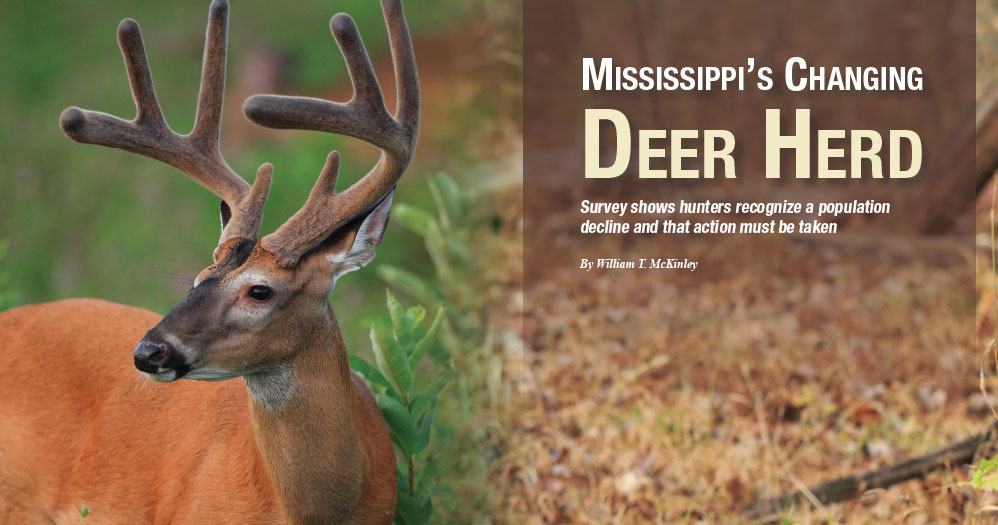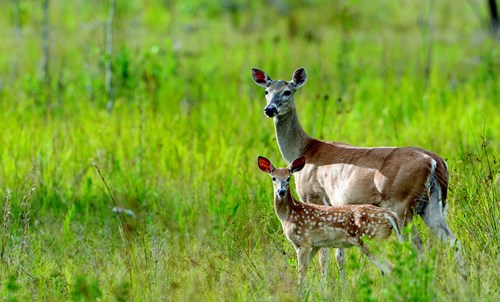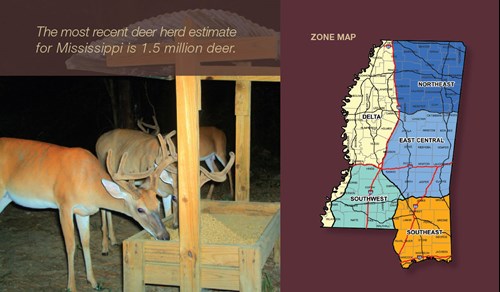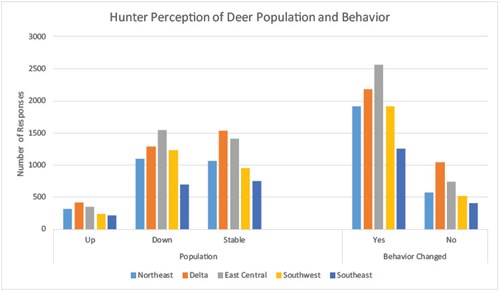Mississippi Outdoors: Mississippi's Changing Deer Herd
9/6/2017 9:10:20 AM
William McKinley

Deer hunters in Mississippi likely have heard about bag limit changes for the 2017–2018 hunting season. For the first time in decades, the bag limit on antlerless deer statewide has been reduced. The purpose of this article is to explain the regulation changes, why those changes were made, and to provide a status on Mississippi’s deer herd.
WHAT IS THE CHANGE?
The Hill Zone has been divided into three zones: Northeast, East Central, and Southwest (see map on page 9). For the 2017–2018 deer season, the bag limit on antlerless deer in the Delta, Northeast, East Central, and Southwest zones has been reduced from five to three. The bag limit on antlerless deer in the Southeast Zone has been reduced from three to two. Additionally, antlerless deer harvest has been suspended on all Open Public Land and some WMAs (see page 8), with the exceptions of early archery season (Sept. 30–Nov. 17 for Delta, Northeast, East Central, and Southwest zones; Oct. 14–Nov. 17 for South-east Zone) and the Youth Deer Hunt, which is the Saturday two weeks before opening day of gun season through the Friday before Thanksgiving (Open Public Lands include National Forests, Corps of Engineers lands, etc., that have statewide seasons without special regulations).
WHY DID IT CHANGE?
White-tailed deer were almost eliminated from Mississippi in the early 1900s because of unregulated hunting. Much of the state was restocked with deer from 1950–1970, and most of that came from the few remaining pockets of deer throughout the state. With virtually unlimited resources and strict protection of antlerless deer, these new herds grew rapidly. By the 1990s, deer were abundant and an antlerless harvest was needed to control deer herds across the state.
Data suggest that the statewide deer herd peaked in number around the late 1990s. It appeared that the deer herd had reached equilibrium (producing about as many deer as were being removed). But nature tends to disrupt equilibriums. New factors, such as disease and predation, began to affect herd growth. Hunters began to complain that deer numbers were down—first in localized areas then, more recently, from all over the state. The annual estimate shows harvest to be on a declining trend. The estimated total deer harvest has decreased by more than 68,000 deer since 2011 and by more than 115,000 deer since the harvest peaked in 1997.
In an effort to find out hunter opinions, the Mississippi Department of Wildlife, Fisheries, and Parks (MDWFP) conducted a statewide hunter opinion survey in April 2017. Hunters were asked about deer populations, deer behavior, and their opinion on proposed changes to the deer season structure. Almost 13,000 hunters responded to the survey, with the vast majority (92.7 percent) being primarily still hunters.
Hunters were asked to respond according to the deer populations on the areas they hunt. The majority of hunters in the Northeast, East Central, and Southwest zones believe the deer population to be down, while the majority of hunters in the Delta and Southeast zones believe the deer population to be stable. Combined results showed that 44.6 percent of hunters believe the population has decreased, 43.7 percent believe the population to be stable, and 11.7 percent believe the population has increased.
Respondents also were asked if they think deer behavior has changed in the area they hunt. More than 75 percent believe it has changed, with the primary causes being weather and human disturbance.
When asked about preferences for deer season and bag limit structure, the top two choices were reducing the doe bag limit (34 percent) and reducing both the buck and doe bag limits (28 percent).
Overall, the survey revealed hunters realize the herd is declining and action needs to be taken.
WHAT HAPPENED TO THE DEER?
First of all, the most recent deer herd estimate for Mississippi is 1.5 million deer. Though the herd appears to be declining, our state can boast of one of the densest deer herds in the nation. Additionally, according to the Quality Deer Management Association, Mississippi leads the country in the harvest of 3.5-year-old-and-older bucks.
A multitude of factors act on Mississippi’s deer herd. In a good habitat with limited mortality, deer herds will double about every three years. This assumes deer receive adequate nutrition and the population is impacted the “normal” mortality (10 percent) from natural causes, the primary one being Hemorrhagic Disease (HD), commonly called blue-tongue. There were six distinct virus strains that caused HD. Because of constant, annual exposure to the virus, deer in Mississippi and many other southeastern states have developed immunity. It still caused some mortality, but greater than 90 percent of the deer exposed did not die and many never showed symptoms. But within the past 10 years a new strain of HD, native to Central America, has entered the country and quickly spread. Death rates were much higher as deer were naive to this new strain. Additionally, known strains of HD have begun to mutate, leading to higher death rates. MDWFP monitors the number of reports of sick deer, attempting to test as many as possible. The number of reports in 2016 was more than six times higher than 2015.
Wild hog numbers also have increased dramatically across Mississippi. Wild hogs directly compete with deer and other native wildlife for food resources. They also prey upon young fawns, but they might present an even greater threat. Wild hogs are known disease reservoirs. The MDWFP is examining research to discover if diseases known to be in wild pigs, such as leptospirosis, are being transferred to deer. The hogs could be infecting deer, through feed and water sources. And, if does are infected, the disease could cause aborted pregnancies or kill nursing fawns. Many of the areas across Mississippi with the sharpest deer declines also happen to be areas with the largest wild hog increases.
While wild hogs will predate young fawns, coyotes and bob-cats also prey on deer. Studies in other southeastern states have shown predators, especially coyotes, can significantly lower fawn survival. Some coyotes in these studies have shown a “learned” response, in that they focus primarily on fawns during key fawning times. Other studies in Pennsylvania and Louisiana have shown black bears to be a top fawn predator, surpassing both coyotes and bobcats.
Coupled with the factors mentioned above are those environmental factors that reduce deer movement, thus resulting in hunters seeing a smaller percentage of the deer on the property. Even though deer feeders are now prevalent across Mississippi, a recent study of properties across the state show that feeding in the manner that it is currently being done is not improving body parameters or increasing the number of animals harvested. When done properly, feeding can have a positive impact on herd health. But on most Mississippi properties where deer are being fed, feeding is not being done in a biologically sound fashion. Disease threats, such as aflatoxicosis, are still possible with feeding, and the full impact of feeding corn or other grains with aflatoxins is not known. Also, predators tend to concentrate at feed sites looking for fawns.

Warmer-than-average winters, as it was during Mississippi’s 2016–2017 deer season, will suppress deer movement. Abundant food, whether it be from a large acorn crop as seen in 2016 or from an abundance of natural browse or deer feed, also will suppress movement.
In summary, most arrows point toward a decreasing deer herd in Mississippi. In some areas, where deer herds have been overpopulated, this could lead to bigger, healthier deer. In other areas, it could simply lead to fewer deer. The MDWFP has taken the first step by reducing the antlerless bag limits and will continue to monitor the statewide deer herd. But in order to better manage the deer herd across the state, we need county-level data, which could be gained from a mandatory deer harvest reporting system. In the sur-vey, 63 percent of hunters expressed support for mandatory harvest reporting.
As Mississippi’s deer herd continues to change, so will the regulations. The MDWFP will strive to keep a healthy, abundant deer herd for our citizens to enjoy, but we cannot succeed without help from the thousands of hunters across our state. We encourage our hunters to make their voices heard.
William McKinley is the Deer Program Coordinator for the MDWFP.











